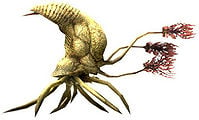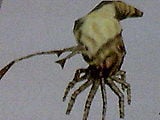Pod infector
From Halopedia, the Halo wiki
Template:Flood Species Infobox
The Flood Infection Form is the first stage of the virulent Flood xenoform and is the most commonly seen stage of the Flood and the form that infects lifeforms to spread the Flood infection.
Description
The Flood Infection Form appears at first glance to be repulsive yet harmless, but once it gains physical contact with a biological host, it becomes an instantly deadly foe. Small tentacles underneath its body penetrate the skin, tap into the victim's spinal cord, and unleash an attack on the host's nervous system via direct contact with the spinal cord, killing them almost instantly. Once this is accomplished, it rewrites the neural pathways of the victim's brain with its tendrils, forcing a resonant frequency match between its neural signals and the host's. Then it releases the Flood Super Cell which overwrites the host DNA and causes rapid mutation. After this is accomplished, it starts to physically move the body, liquefying the organs to create the tentacles on the left hand from the calcium obtained and finally nest itself within the chest cavity of its host. All this happens within a matter of seconds. In exceedingly rare cases, such as if the Infection Form has been damaged or is incredibly old, it will actually go through this process without killing the host, leaving them at least partially aware of what is going on, but unable to move or act. This was the fate of UNSC Private Wallace A. Jenkins. If infection of a specific creature is not possible, that being will be totally ignored by the Infection form, leaving other Flood forms the task of killing it, although it is likely that the Flood will use the incompatible body for later sustenance. An Infection Form may also abandon its host if the corpse has been heavily damaged, and look for a new one. Several Infection Forms, sometimes ranging from 5 to 15 Infection Forms at once, can attack certain victims. Infection forms appear at first glance, to be quite small, but if you compare them with the average Human, you can see that they are actually quite large; roughly the size of a man's torso.
Immunities/Defenses
Energy Shield Systems negate the effect of the infection form by causing it to explode on contact in a small, damaging cloud of gas (making it a good use of shield, saving ammo, by letting them hit your shields); however, if there is no shield system present on the target, the infection process begins.
At this time, the only known Human subject to be incompatible with Flood Infection Forms is Sergeant Johnson due to his supposed contracting of Boren's Syndrome from the residual radiation of a crate full of Plasma Grenades, however, he actually contracted immunity from the drugs he took on the SPARTAN-I Program. According to a UNSC analysis of various Flood forms,[1] the Kig-Yar and Unggoy lack the necessary calcium stores and biomass to be converted into Combat Forms and are instead used as biomass stores, but Halo Wars stated that the Unggoy and Kig-Yar could be infected.
There are theories on other racial immunities to the Flood. The most straightforward would be the the Mgalekgolo's lack of a central nervous system[2] and nature as an invertebrate colony consisting of multiple worms. The invertebrate nature of the Yanme'e, along with their hard, chitinous exoskeleton would seem to make them immune as well.
Deterioration
An Infection Form is capable of losing its infectious potential over time. This was experienced by Private First Class Wallace A. Jenkins during the raid on the "Covenant Weapons Cache" on Installation 04.[3] This aged version of the Infection Form must have been kept in captivity for far too long, thereby reducing its potential of complete transformation of its host into a Flood Combat Form. Jenkins was only partially controlled, as there were periods of time where he could control his body and mind to some degree.
Combat
Infection Forms will gather in large swarms, attacking with their claws and tentacles. If the victim's shields are active, as explained earlier, the Infection Form will burst. However, the sheer force of numbers can sometimes deplete a victim's shields, allowing these Flood forms to take control of the Human/Brute/Elite body.
A single round from any weapon will burst an Infection Form. For this reason, automatic weapons are recommended. Dual-wielding Plasma Rifles, Brute Plasma Rifles, Spikers, or using a UNSC ballistic weapon all work well. The Battle Rifle, with its bursts of fire, can be quite effective, the Shotgun works well too when shooting at large groups closing in. Try to avoid using weapons such as M6 Handguns, or Plasma Pistols, as their rate of fire is very low. Also, try to avoid using Grenades, as they close in extremely quickly and you may suffer damage from your own grenade. In Halo: Combat Evolved, automatic weapons like the Assault Rifle and Plasma Rifle are good on them, the Needler in many ways can also be good: be careful though, do not stick too many Needles on one at a time while they are close as if you do it will explode and effect you most likely depleting your shields. SMGs are incredibly effective for taking on swarms of Infection Forms with its large magazine size and impressive rate of fire.
Infection Forms are spawned from bulging, sac-like pods in Flood Hives, called the Flood Growth Pods. It may be tempting to destroy these sacs, but it is actually more advisable not to, since destroying them will not kill the Infection Forms inside.
Trivia
- Infection Forms are carried and incubated by Carrier Forms and from Flood Growth Pods in Flood-infested areas. Try not to destroy these sacs, unless you think you can take them one by one, or swarm by swarm.
- In Halo: The Flood, Infection Forms are mistakenly referred to as being colored white.[4]
- The Infection Form has appeared in two Action Figure sets: the Halo 1 Flood Carrier Form Action Figure and the Halo 2 s8 Master Chief v4 Action Figure. The differences between the two versions were significant, namely the first Infection Form featured a detachable membrane that revealed the internal organs of the creature.
- An Energy Sword will not lose energy by killing Infection Forms in Halo 2 and 3, but this method is highly ineffective as Infection Forms are extremely hard to hit with an Energy Sword.
- On Cold Storage, if the player walks up to the infection form room, an infection form will come over and scrape the glass in an effort to attack the player.
- The Tank Form has the ability to spit out Infection Forms. This is demonstrated during Halo 3 for the Tank Form and Halo 2 for Gravemind.
- Infection Forms do not add points to your meta-score when the Campaign Scoring is activated in Halo 3. This is most likely because Infection Forms come in swarms, and could be used to rack up points with almost no effort.
- Infection Forms operate in a similar fashion to the Chestburster Xenomorph(being inside a host's chest) and the Facehugger Xenomorph of the Alien franchise, the Borg Nanites of the Star Trek franchise, the Headcrabs from the Half-Life series, and The Thing from the John Carpenter film of the same name.
- The Infection Forms in Halo 3 float in water. Thus, they cannot infect corpses that are in water ponds because of this animation. (E.g. on the level Halo it will appear different close up then it will farther away.) However, in Halo Combat Evolved, they sink.
- In the book Halo: The Flood, an Infection Form almost infected John-117 when he turned his back, due to his energy shields being drained.
- According to the book, Halo: The Flood, the Infection Forms make a "meep" sound. This can be heard in the games, although it sounds more like an ominous droning.
- In Halo: Combat Evolved, if you shoot one Infection Form in a swarm, it will pop and cause a chain reaction causing all the other Infection Forms to pop with it in the swarm. This was less effective in Halo 2, but returned in Halo 3 (although not as powerful as in Halo: Combat Evolved).
- Several can be seen within the Flood Observation chamber on the Halo 3 Multiplayer map Cold Storage. These Flood make Cold Storage the 6th multiplayer map with NPC enemies (Along with Construct, Guardian, Last Resort, Epitaph and Isolation which have Sentinels, Constructors, seagulls or pterodactyl-like birds flying around). But, you cannot get to them.
- In Halo: Combat Evolved, the Infection Forms have a pulsating glow.
- Through the Halo trilogy, Infection Forms seem to take on physiological and biological changes from game to game; this could be due to the Gravemind's influence.
- The Infection Form was featured in Halo Wars as a non-playable unit for the Flood. They have the ability to crawl over walls, being able to reach ground no other forces can reach and infect most infantry.
- On the Halo 3 level Halo, when in the Warthog, Mongoose, Chopper, etc., if you drive into the Infection Forms you simply drive over them, possibly flipping your vehicle. Doing this action kills all other Flood forms except the carrier forms, which explode on contact.
- In Halo: Combat Evolved, if players listen close enough to the droning sounds emitted by the Infection Forms, it can be noted that the sounds are actually the same sounds used for "Pfhor Fighters" death screams and occasional random chattering from the Marathon franchise. However, the sounds have a slightly higher pitch, as well as oozing sounds, which make the reuse of the sound effect from Marathon almost completely unnoticeable.
Gallery
- 253850-flood infection form large.jpg
Flood Infection form in Halo: Combat Evolved
- BabyFloodCloseup.jpg
A Halo 2 Infection Form.
Sources
- ^ Halo: The Flood
- ^ Halo: First Strike
- ^ Halo: The Flood, page 176
- ^ Halo: The Flood page 174
| |||||||||||||||||||||||||||||||||


